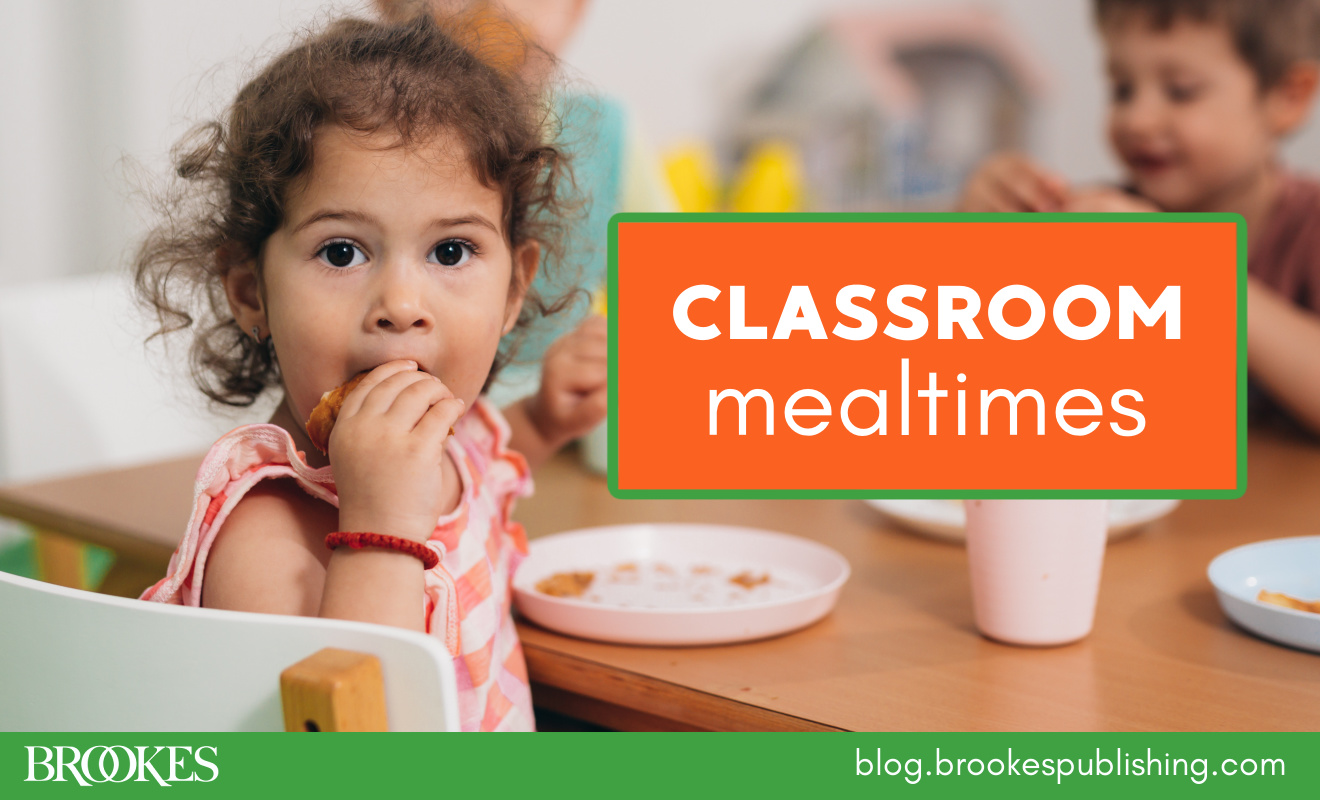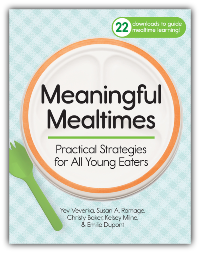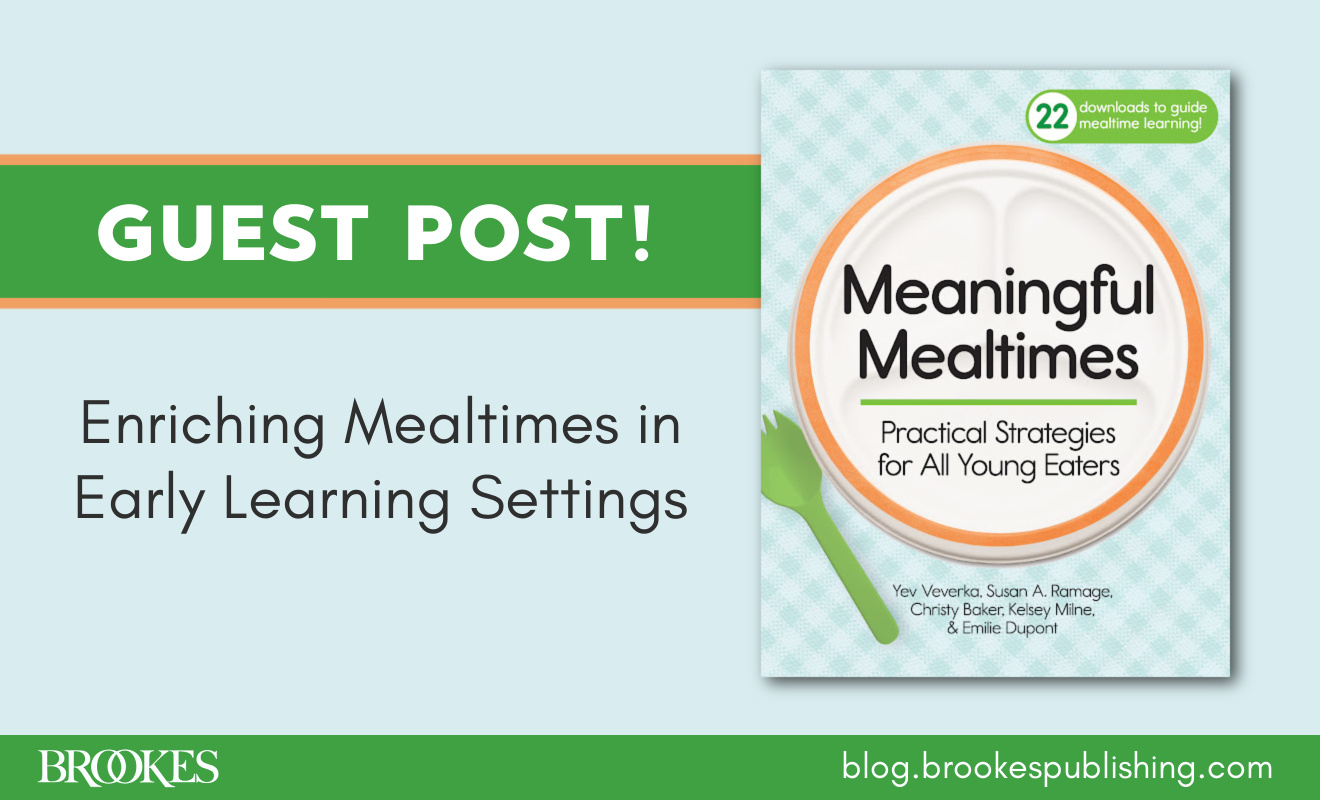5 Ways to Create a Regulating Space at Classroom Mealtime
April 15, 2025
 Today’s post is adapted from Meaningful Mealtimes by Yev Veverka, Susan A. Ramage, Christy Baker, Kelsey Milne, & Emilie Dupont—a practical, inclusive guide to making mealtimes fulfilling and meaningful experiences for all young children in early learning environments.
Today’s post is adapted from Meaningful Mealtimes by Yev Veverka, Susan A. Ramage, Christy Baker, Kelsey Milne, & Emilie Dupont—a practical, inclusive guide to making mealtimes fulfilling and meaningful experiences for all young children in early learning environments.
For young sensory systems (and for older ones, too!), it can be challenging to focus on mealtime when there’s a lot of sensory clutter in the surrounding environment. During mealtimes in your early learning environment, it can be helpful to reduce or mute other sights, sounds, or smells so that children are better able to focus on the sensory experience of the meal itself. Here are five things to try:
Reduce visual distractions. Consider reducing visual distractions by cleaning up other activities prior to mealtime—putting toys and other materials away or out of sight. Closing closet and cupboard doors, turning movable shelves to face the wall, or covering shelves and materials with fabric are other ways to reduce visual clutter. Turning off screens and dimming or covering bright lights can be restful for the visual system, too.
Turn down the sound. It may be helpful to reduce any noise from outside and turn off screens or music (or switch to music with a slow, rhythmic pace, played at a low volume, or white or brown noise). This will be sufficient for many children. As a Tier 2 support for children who may be more sensitive to noise, consider providing noise-reducing headphones or seating the child near classmates who tend to be quieter. Speaking at a lower volume and using a slower pace may also create a calmer environment.
Banish strong smells. Consider fragrances or smells that might be present in your room. For those sensitive to smell, mixing the smell of food with other scents may be aversive. Be mindful of any cleaning sprays, air fresheners, or diffusers used in your room, and make sure that these smells dissipate before mealtimes begin. If possible, wash hands with unscented soaps. Avoid the strong smells of hand sanitizers or wipes in place of soap and water, or at least use them away from foods.
Consider tactile experiences. Children who are sensitive to touch or seek out specific textures may benefit from careful attention to the tactile experience of mealtime. Some children will need more tactile input to feel regulated during meals. You may wish to have a few fidget toys available at mealtime for children who find comfort in carrying or manipulating small toys, or in holding and squeezing an object to help calm and maintain focus. Some children find that chewy toys help regulate their nervous system; these are a hands-free option that could promote engagement during mealtime.
Offer opportunities for movement. During the day and particularly before meals, children who seek out vestibular and/or proprioceptive input may benefit from opportunities for movement. Movement can help alert their systems if they are tired or achieve the sensory input their body craves in order to calm and attend to mealtime. Wiggle cushions can be helpful for children who struggle to sit still. More supportive seating might be needed if stability and postural control are a challenge.
Note that some people with sensory processing difficulties may require their own unique set of environmental conditions for their bodies to feel regulated and ready to eat. What may be distracting to one child could help with regulation for another child. Gather information about what the individual children in your setting might need (see Meaningful Mealtimes for guidance on how to do that!). Often, balance and creative problem solving will be needed to meet potentially conflicting needs. For example, you might play calm music softly and place the speaker next to one child who needs it to feel regulated, while seating another child for whom sounds are distracting at a distance.
The goal of looking closely at the environment is to make sure the mealtime environment is as calm, regulating, and free of outside distractions as possible, so it’s easier to be present and attentive to the eating experience. As you consider your environment, start by thinking about overall changes that could benefit the group as a whole, knowing that you might need to make additional adaptations for specific individuals so you can meet their unique sensory needs within your space.
For much more practical guidance on making mealtimes fulfilling and meaningful experiences for all young children, get this user-friendly new planning guide, the first of its kind for early childhood educators and care providers!




Write a Comment
Your email address will not be published. Required fields are marked *
Post a Comment